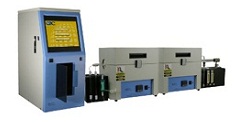TOTAL SULFUR

The UIC, Inc. Total Sulfur Analyzer rapidly and directly determines sulphur from a wide variety of sources including organics, coal, geologic materials, inorganics and natural products.
PRINCIPLES OF OPERATION
The coulometer cell is filled with a solution which initially contains a slight excess of free iodine. When SO2 enters the cell, iodine is consumed. The amperometric-sensing circuit detects the deficiency of iodine in the solution and causes iodine to be electrically generated at a rate proportional to the sensed deficiency. When all of the SO2 has been titrated, the iodine is restored to its initial concentration. The total current used to generate the iodine is integrated by the coulometer and digitally displayed in user-selectable units, usually micrograms S.
Samples are weighed into a ceramic combustion boat and covered with vanadium pentoxide (V2O5). The sample is introduced into a 1050˚C combustion furnace and oxygen is introduced into the nitrogen carrier gas. The combustion products are passed over a combustion catalyst to ensure complete decomposition and are also passed over copper to quantitatively convert all sulfur to SO2. The SO2 is swept into the coulometer cell, where it is quantitatively absorbed and coulometrically titrated, as described above.
Conversion of sulfur to SO2 is not matrix-dependent as in many other high temperature sulfur analyzers. Complete conversion of sulfur to SO2 and coulometric measurement eliminates the need for standardization and/or sample calibration.
PROCEDURE
- Weigh a sample containing from 0.1 to 10 mg S. (The range of S given is the optimum range of S for detection. Larger amounts can be determined but will extend the analysis time. Conversely, smaller amounts may affect accuracy due to sample handling.)
- Cover the sample with S-free V2O5 and place the boat containing the sample into the combustion tube. Seal the end of the tube and move the boat into the furnace.
- Immediately reset the coulometer and inject oxygen into the system. When the coulometer reading is stable, (approximately five minutes), record the micrograms S from the coulometer display.
- A blank run with only V2O5 should be performed to ascertain the instrument blank and a known sample should be run occasionally to confirm proper operation of the system.
MAINTENANCE
The coulometer cell solution should be changed after approximately 250 mg of S has been titrated. The copper tube filling must be regenerated or replaced when it becomes oxidized to within 2 cm of the end of the filling. In-house laboratory test have indicated several hundred analyses before the need to regenerate.
RESULTS
The % in the sample is calculated as follows:
% S = (ug S Coulometer reading) – (ug S Blank) X 100
Ug Sample
Or, alternatively, ppm S is calculated as follows:
Ppm S = (ug S Coulometer reading) – (ug S Blank)
g Sample
TABLE I.
| SAMPLE | WT. RANGE (mg) | THEORY %S | FOUND %S | # OF RUNS | RANGE FROM AVG. %S | STANDARD DEVIATION |
| Dibenzyl Disulphide | 2-50 | 26.03 | 26.06 | 8 | 0.18 | 0.10 |
| Coal-Std. (4.03% S) | 20-50 | 4.03 | 4.02 | 5 | 0.04 | 0.02 |
| BaSO4 | 5-10 | 13.74 | 13.52 | 2 | 0.06 | 0.08 |
| Na2SO4 (98.5% Pure) | 20-25 | 25.05 | 24.98 | 2 | 0.03 | 0.04 |
| Sulfamic Acid | 5-20 | 33.02 | 32.90 | 2 | 0.01 | 0.01 |
TABLE II.
SPECIFICATIONS
| Titration Rate | – | 2400 ug S per minute |
| Accuracy | – | 0.15% +/-2 digits for standard range |
| Sensitivity | – | 0.1 ug S |
| Calibration | – | Factory Set |
| Typical Analysis Time | – | 5 minutes |
| Range | – | ppm to 100% |




